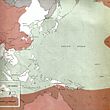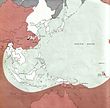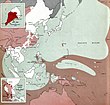
The Southern Expeditionary Army Group was a general army of the Imperial Japanese Army during World War II. It was responsible for all military operations in South East Asian and South West Pacific campaigns of World War II. Its military symbol was NA.

Jaluit Atoll is a large coral atoll of 91 islands in the Pacific Ocean and forms a legislative district of the Ralik Chain of the Marshall Islands. Its total land area is 11.34 square kilometers (4.38 sq mi), and it encloses a lagoon with an area of 690 square kilometers (270 sq mi). Most of the land area is on the largest islet (motu) of Jaluit (10.4 km2). Jaluit is approximately 220 kilometers (140 mi) southwest of Majuro. Jaluit Atoll is a designated conservation area and Ramsar Wetland.

Shōji Nishimura was an admiral in the Imperial Japanese Navy during World War II.
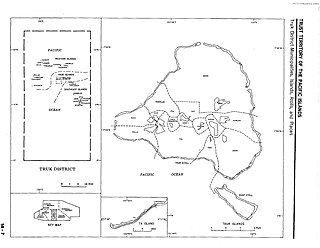
Chuuk Lagoon, previously Truk Atoll, is an atoll in the central Pacific. It lies about 1,800 kilometres northeast of New Guinea and is part of Chuuk State within the Federated States of Micronesia (FSM). A protective reef, 225 kilometres (140 mi) around, encloses a natural harbour 79 by 50 km, with an area of 2,130 km2 (820 sq mi). It has a land area of 93.07 square kilometres, with a population of 36,158 people and a maximal elevation of 443 metres (1,453 ft). Weno city on Weno Island functions as both the atoll's capital and the state capital, and is the largest city in the FSM with its 13,700 people.
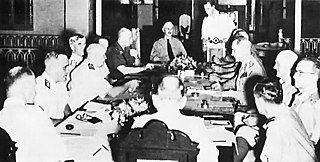
The American-British-Dutch-Australian (ABDA) Command, or ABDACOM, was the short-lived supreme command for all Allied forces in South East Asia in early 1942, during the Pacific War in World War II. The command consisted of the forces of Australia, the Netherlands, United Kingdom and the United States. The main objective of the command, led by General Sir Archibald Wavell, was to maintain control of the "Malay Barrier", a notional line running down the Malay Peninsula, through Singapore and the southernmost islands of the Dutch East Indies. ABDACOM was also known in British military circles as the "South West Pacific Command", although it should not be confused with the later South West Pacific Area command.

The Battle of Sunda Strait was a naval battle which occurred during World War II in the Sunda Strait between the islands of Java, and Sumatra. On the night of 28 February – 1 March 1942, the Australian light cruiser HMAS Perth, American heavy cruiser USS Houston, and Dutch destroyer HNLMS Evertsen faced a major Imperial Japanese Navy (IJN) task force. After a fierce battle lasting several hours, all Allied ships were sunk. Five Japanese ships were sunk, three of them by friendly fire.

The Battle of Makassar Strait, also known as the Action of Madura Strait, the Action North of Lombok Strait and the Battle of the Flores Sea, was a naval battle of the Pacific theater of World War II. An American-British-Dutch-Australian (ABDA) fleet—under Schout-bij-nacht Karel Doorman—was on its way to intercept a Japanese invasion convoy reported as bound for Surabaya, when it was attacked by 36 Mitsubishi G4M1 "Betty" and 24 Mitsubishi G3M2 "Nell" medium bombers, which forced the fleet to retreat.

Fubuki was the lead ship of twenty-four Fubuki-class destroyers, built for the Imperial Japanese Navy following World War I. When introduced into service, these ships were the most powerful destroyers in the world. They served as first-line destroyers through the 1930s, and remained formidable weapons systems well into the Pacific War. Fubuki was a veteran of many of the major battles of the first year of the war, and was sunk in Ironbottom Sound during the Battle of Cape Esperance in World War II.

USS Childs (DD-241/AVP-14/AVD-1) was a Clemson-class destroyer in service with the United States Navy from 1920 to 1945. She was scrapped in 1946.

Naka (那珂) was a Sendai-class light cruiser in the Imperial Japanese Navy (IJN), named after the Naka River in the Tochigi and Ibaraki prefectures of eastern Japan. Naka was the third vessel completed in the Sendai class of light cruisers, and like other vessels of her class, she was intended for use as the flagship of a destroyer flotilla.

Shirakumo was a Fubuki-class destroyer and the eighth in a class of twenty-four vessels built for the Imperial Japanese Navy following World War I. When introduced into service, these ships were the most powerful destroyers in the world. They served as first-line destroyers through the 1930s, and remained formidable weapons systems well into the Pacific War.
Takeo Itō was a general in the Imperial Japanese Army during World War II.

Ibō Takahashi was an admiral in the Imperial Japanese Navy during World War II.

Kiyotake Kawaguchi was a general in the Imperial Japanese Army during World War II.

Shintarō Hashimoto was an admiral in the Imperial Japanese Navy during World War II.
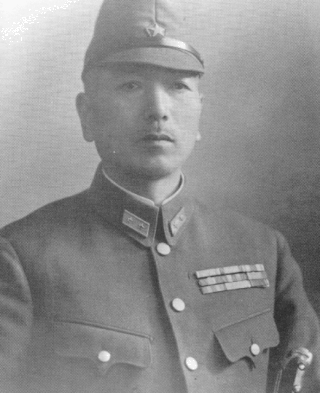
Masao Maruyama, was a Lieutenant General and commander in the Imperial Japanese Army during World War II.
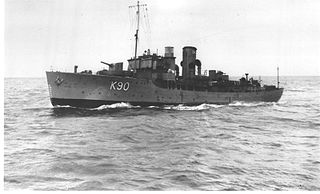
HMS Gentian was a Royal Navy Flower-class corvette that served in the Battle of the Atlantic during World War II.

ToshinariShōji was a major general in the Imperial Japanese Army during the Pacific campaign in World War II.
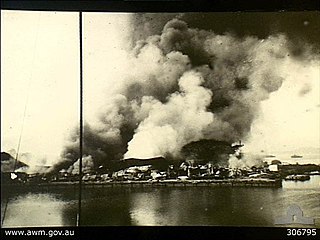
The Invasion of Sumatra was the assault by Imperial Japanese forces on the Dutch East Indies that took place from 14 February to 28 March 1942. The invasion was part of the Pacific War in South-East Asia during World War II and led to the capture of the island. The invasion of Sumatra was planned to occur prior to the invasion of Java to destroy the west flank of the allies and to give access to Java.
 1937-07-07 – 1937-07-09 Marco Polo Bridge Incident
1937-07-07 – 1937-07-09 Marco Polo Bridge Incident  1937-08-13 – 1937-11-26 Battle of Shanghai
1937-08-13 – 1937-11-26 Battle of Shanghai  1937-09-01 – 1937-11-09 Battle of Taiyuan
1937-09-01 – 1937-11-09 Battle of Taiyuan  1937-12-09 – 1938-01-31 Battle of Nanjing
1937-12-09 – 1938-01-31 Battle of Nanjing  1938-03-24 – 1938-05-01 Battle of Xuzhou
1938-03-24 – 1938-05-01 Battle of Xuzhou  1938-06-11 – 1938-10-27 Battle of Wuhan
1938-06-11 – 1938-10-27 Battle of Wuhan  1939-03-17 – 1939-05-09 Battle of Nanchang
1939-03-17 – 1939-05-09 Battle of Nanchang  1939-04-20 – 1939-05-24 Battle of Suixian-Zaoyang
1939-04-20 – 1939-05-24 Battle of Suixian-Zaoyang  1939-09-13 – 1939-10-08 Battle of Changsha (1939)
1939-09-13 – 1939-10-08 Battle of Changsha (1939)  1939-11-15 – 1940-11-30 Battle of South Guangxi
1939-11-15 – 1940-11-30 Battle of South Guangxi  1940-05-01 – 1940-06-18 Battle of Zaoyang-Yichang
1940-05-01 – 1940-06-18 Battle of Zaoyang-Yichang  1940-08-20 – 1940-12-05 Hundred Regiments Offensive
1940-08-20 – 1940-12-05 Hundred Regiments Offensive  1941-01-30 – 1941-03-01 Battle of South Henan
1941-01-30 – 1941-03-01 Battle of South Henan  1941-03-14 – 1941-04-09 Battle of Shanggao
1941-03-14 – 1941-04-09 Battle of Shanggao  1941-05-07 – 1941-05-27 Battle of South Shanxi
1941-05-07 – 1941-05-27 Battle of South Shanxi  1941-09-06 – 1941-10-08 Battle of Changsha (1941)
1941-09-06 – 1941-10-08 Battle of Changsha (1941)  1941-12-24 – 1942-01-15 Battle of Changsha (1942)
1941-12-24 – 1942-01-15 Battle of Changsha (1942)  1942-05-14 – 1942-09-07 Zhejiang-Jiangxi Campaign
1942-05-14 – 1942-09-07 Zhejiang-Jiangxi Campaign 
 1943-05-12 – 1943-06-03 Battle of West Hubei
1943-05-12 – 1943-06-03 Battle of West Hubei  1943-11-02 – 1943-12-20 Battle of Changde
1943-11-02 – 1943-12-20 Battle of Changde  1944-04-17 – 1944-12-10 Operation Ichi-Go
1944-04-17 – 1944-12-10 Operation Ichi-Go  1945-03-21 – 1945-05-11 Battle of West Henan–North Hubei
1945-03-21 – 1945-05-11 Battle of West Henan–North Hubei 
 1945-04-09 – 1945-06-07 Battle of West Hunan
1945-04-09 – 1945-06-07 Battle of West Hunan  1945-04-18 — 1945-08-04 Second Guangxi Campaign
1945-04-18 — 1945-08-04 Second Guangxi Campaign ![]() Soviet–Japanese border conflicts
Soviet–Japanese border conflicts 